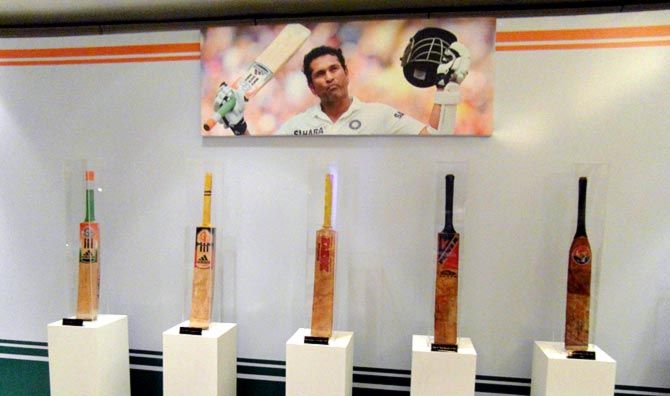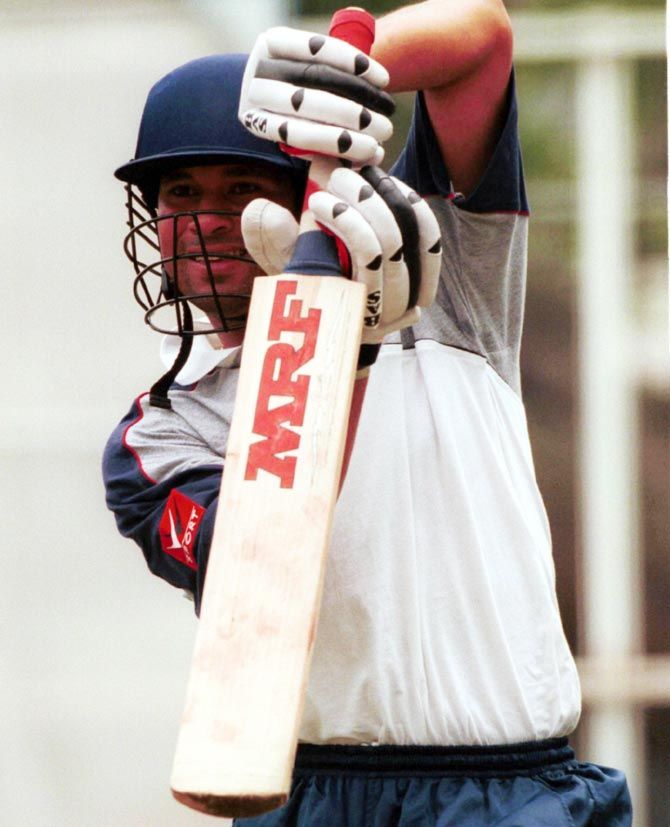'I used a pretty heavy bat and I was sometimes encouraged to move to a lighter one. Again, I did try but I never felt comfortable, as my whole bat swing depended on that weight.'
'If you make technical adjustments, such as moving to a lighter bat, to cope with different conditions, there's a risk of making yourself feel uncomfortable and of thinking too much about your technique.'

India's batting legend Sachin Tendulkar explains why he never used a lighter bat despite several injuries during his 24 year-long playing career. In his recently-released autobiography, Playing It My Way, he points out that a lighter bat never worked for him because it affected his timing.
Sachin Tendulkar, who battled several injuries including tennis elbow in 2004, has revealed that he was asked several times to reduce the weight of his bat but did not as he was never convinced about it.
"I used a pretty heavy bat and I was sometimes encouraged to move to a lighter one. Again, I did try but I never felt comfortable, as my whole bat swing depended on that weight. When I was hitting a drive, I needed the weight to generate the power. It was all to do with the timing," he said.
Tendulkar, who has broken nearly all batting records in cricket, also explained how he used to hold the bat.
- Buy the Book Right Here on Rediff
"To me the bat should be an extension of your arm, and if you've reached the stage where it's become an extension of your arm, why do you need to change? What mattered to me most when I was batting was feeling comfortable.
"As long as I felt comfortable, it didn't matter where I was playing or who I was playing against. If you make technical adjustments, such as moving to a lighter bat, to cope with different conditions, there's a risk of making yourself feel uncomfortable and of thinking too much about your technique."

Tendulkar also advised youngsters against too much experimentation, saying the "bat should be an extension of your arm" and there is no need for a change in technique if "you have reached that stage".
He pointed out that as far as his own grip was concerned it was very low on the handle, something he was used to since he was a kid.
"People have often commented on my own grip, which is very low down on the handle. It all goes back to when I started playing cricket when I was eleven with my brother Ajit, who is ten years older. As I didn't have a bat of my own, I had to use Ajit's full-size bat and the only way I could cope with the weight at that age was to hold the bat right at the bottom of the handle," Tendulkar said.
"Some coaches suggested changing my grip, and I did experiment, but it never felt right. I had got used to feeling the end of the handle pressing against the inside of my forearm and if I gripped the bat further up I didn't have that, and batting just didn't feel natural.
"That's not to say that my technique didn't change at all, though. Throughout my career, I was always looking to improve and constantly tried new things to cope with different situations. My backlift changed significantly over the years, for example," he explains.

Tendulkar said it is important to try and read the bowler's mind rather than thinking too much about "your own batting".
"I've always felt that I've batted best when my mind has been at the bowler's end of the pitch, not at my end. In fact, for both batsmen and bowlers, I've always believed that cricket is played best when your mind is at the opposite end and that problems occur when your mind is stuck at your own end.
"For example, if a bowler is thinking too much about bowling no-balls, he's not going to be able to bowl what he wants to bowl. Instead, his mind should be at the batsman's end, focusing on where he's going to pitch the ball, which way he's going to swing it and so on.
"As a batsman, if I'm not consciously worrying about my footwork or my backlift or my wrist-work, then I know that I'm in the right space, because my mind needs to be at the opposite end, figuring out what the bowler is trying to do. There's no time to think about both ends at the same time," he says.











